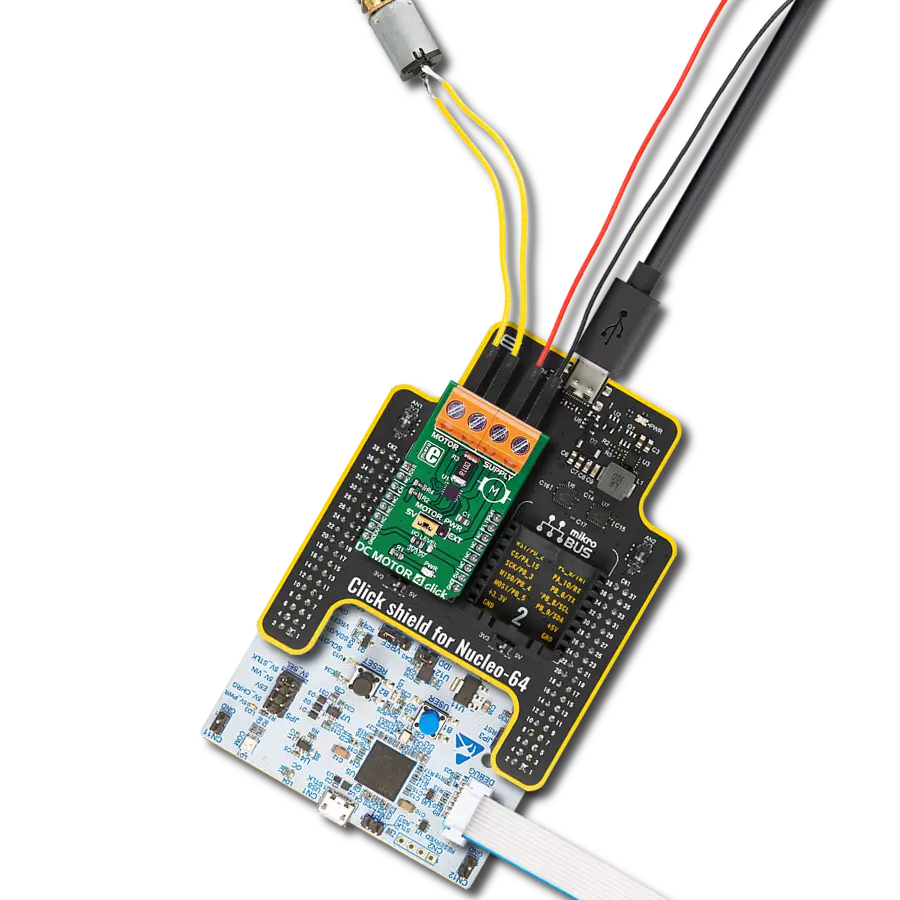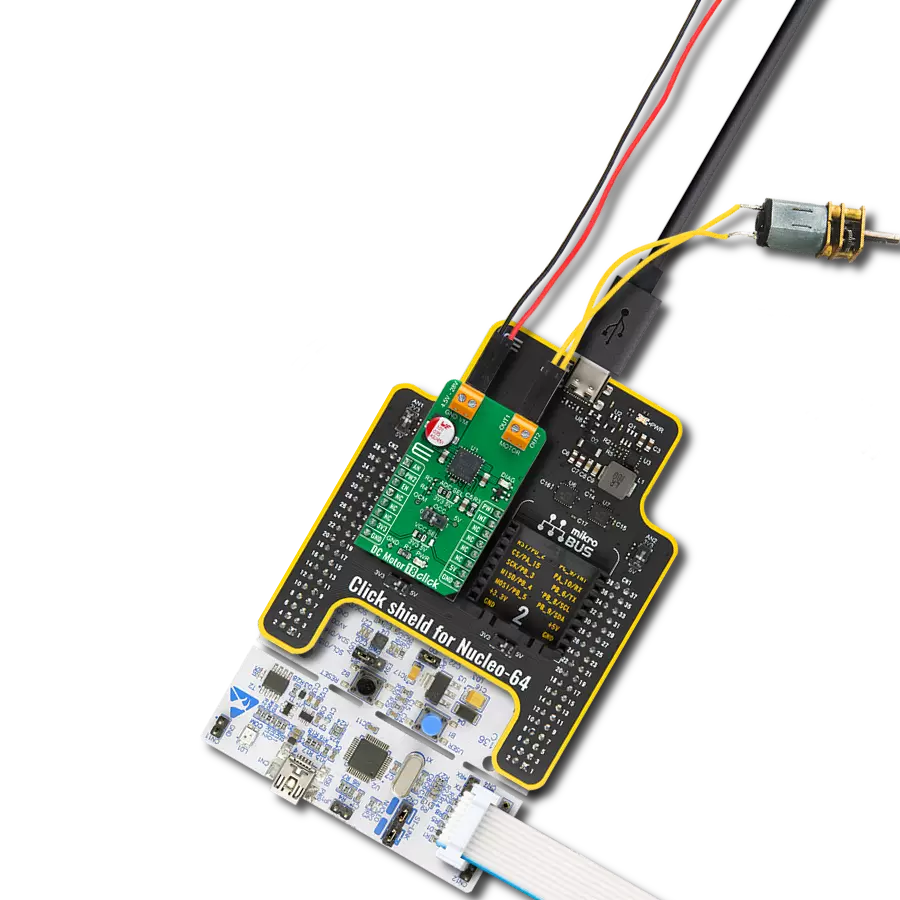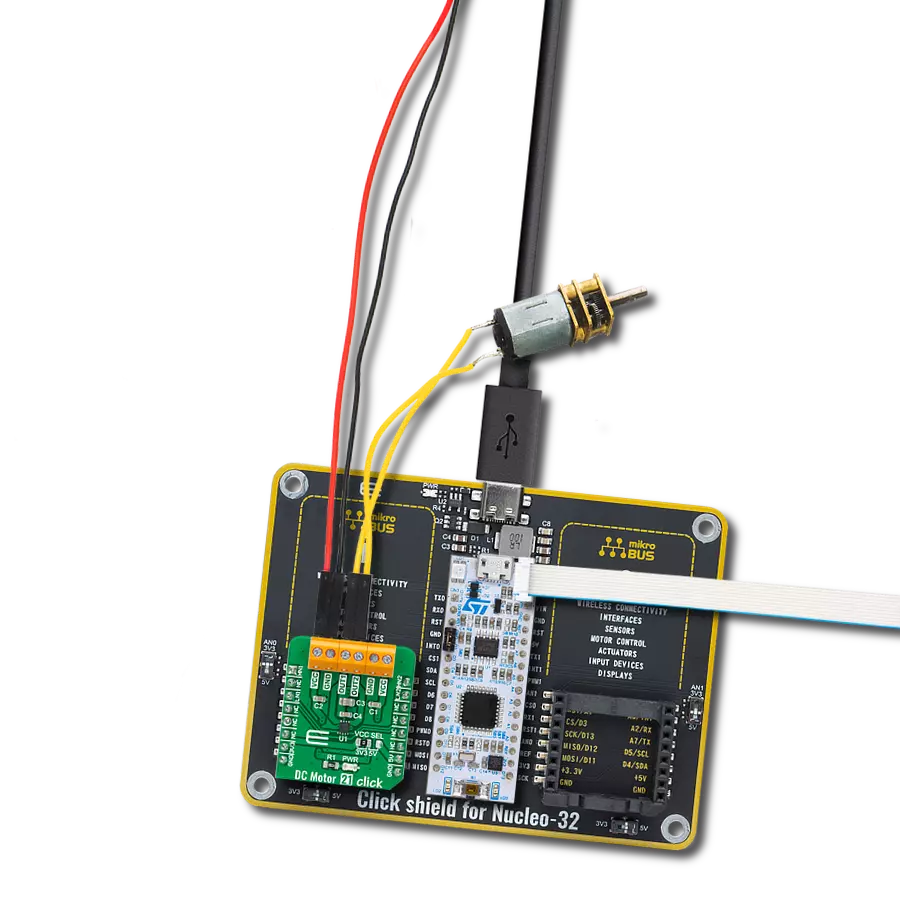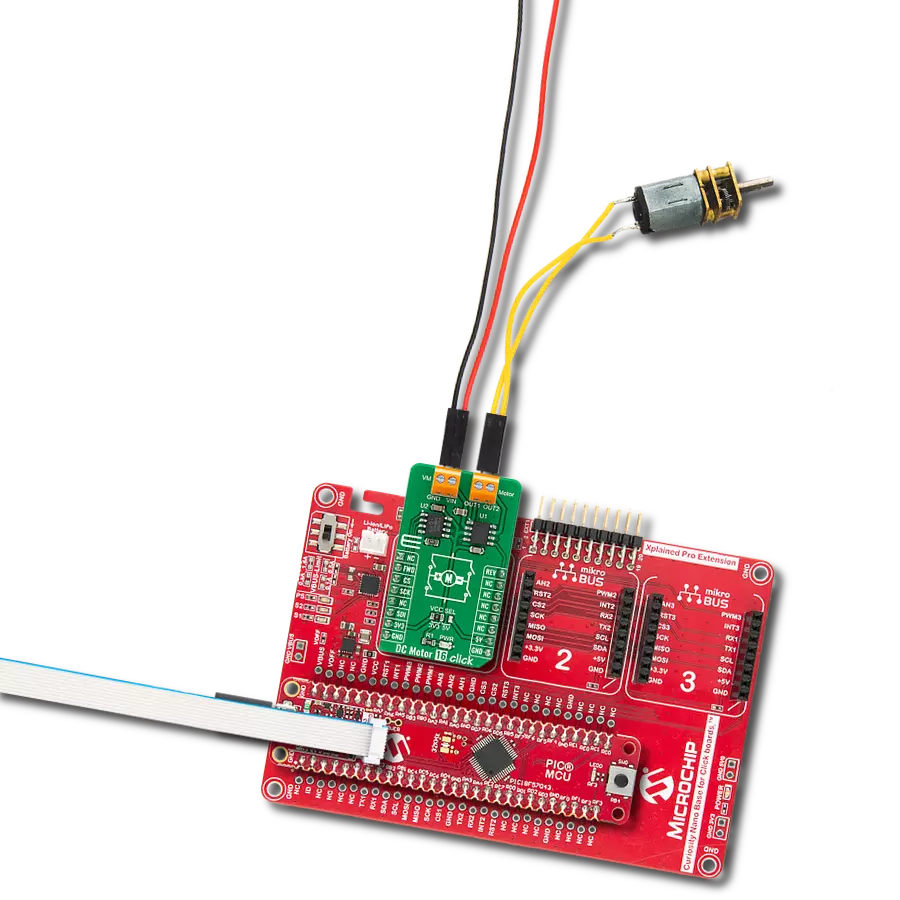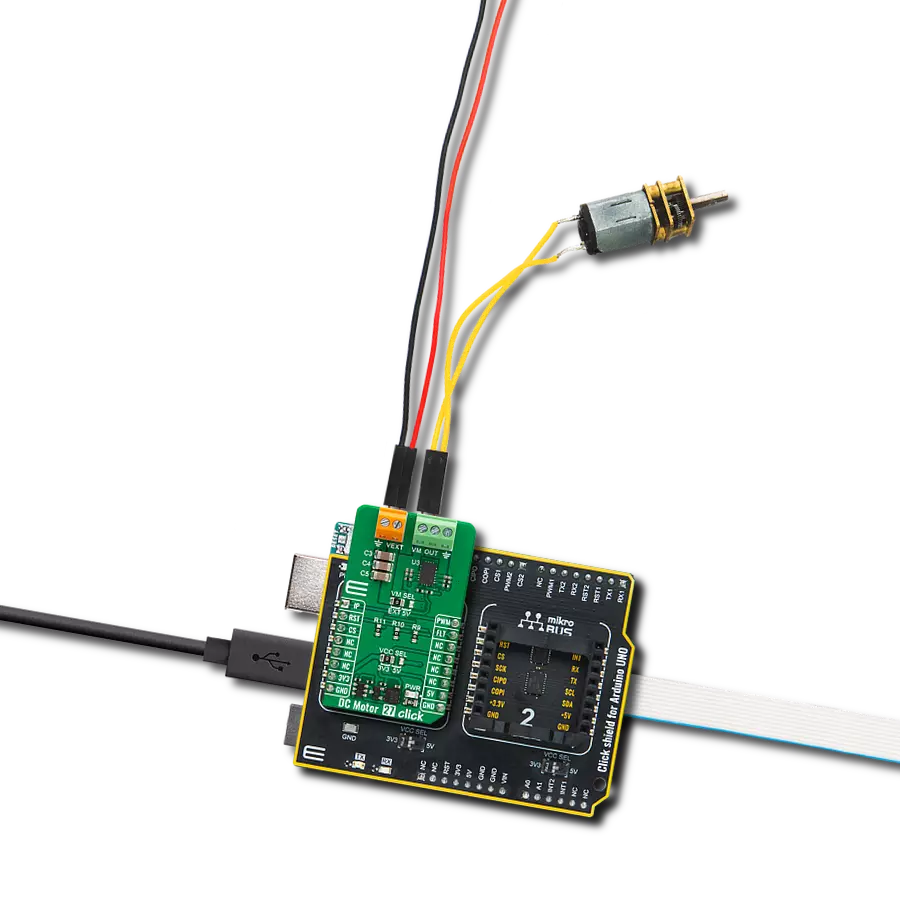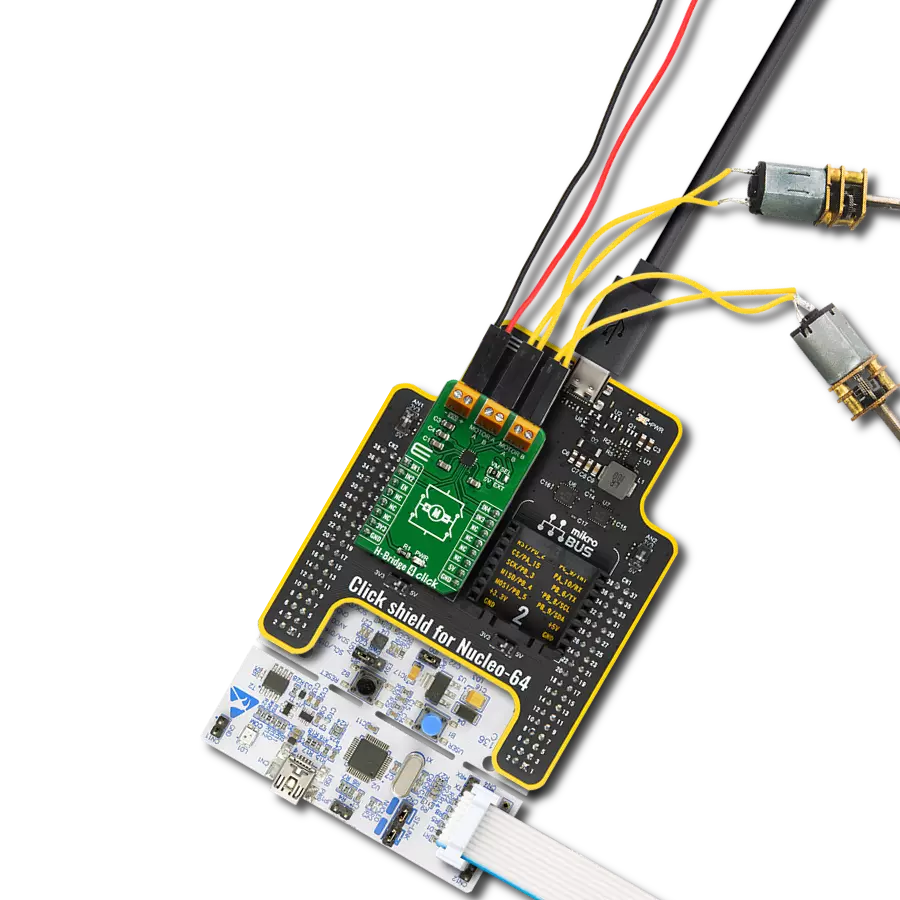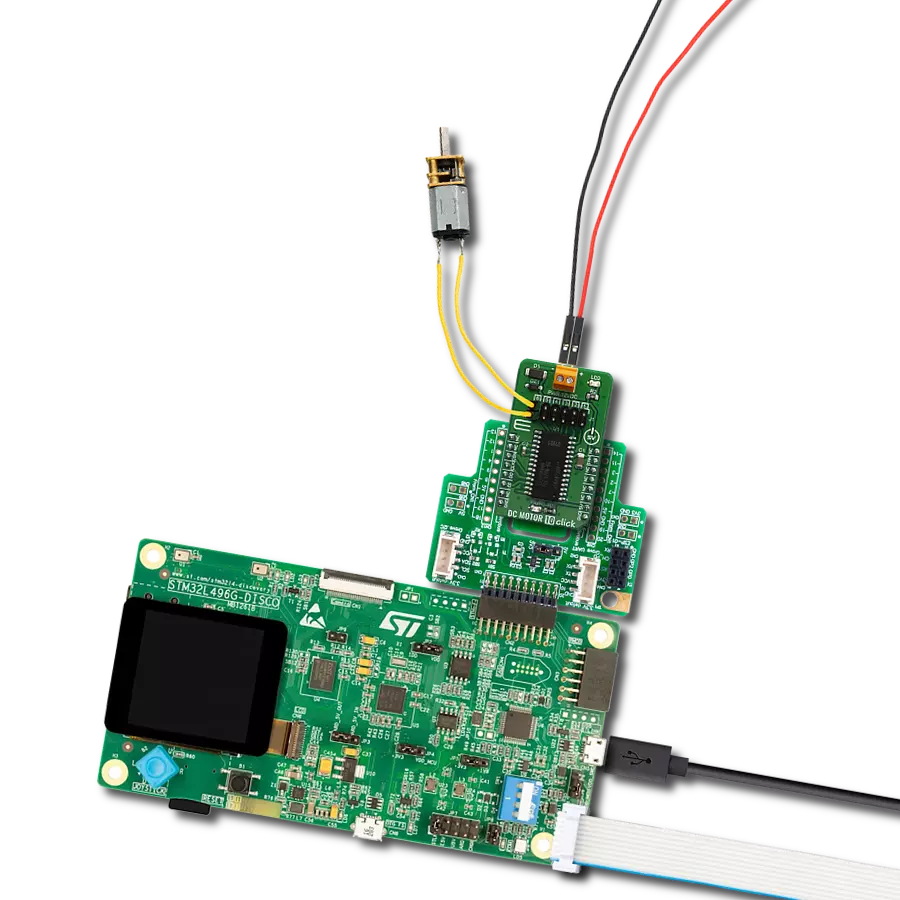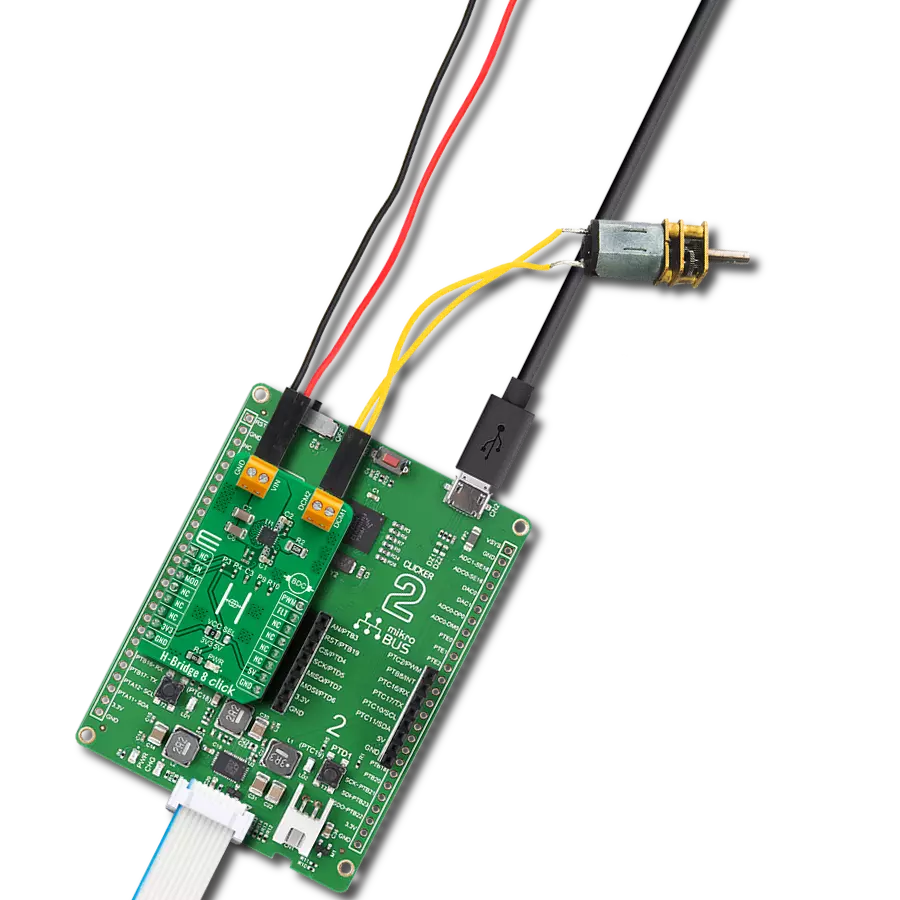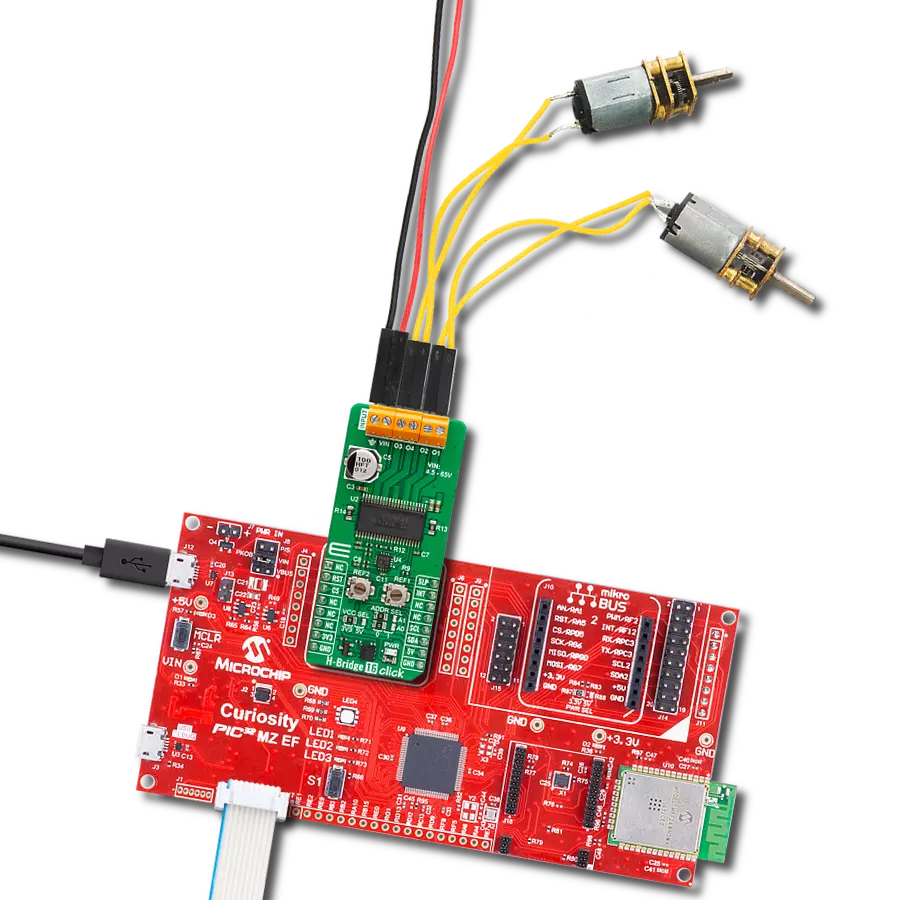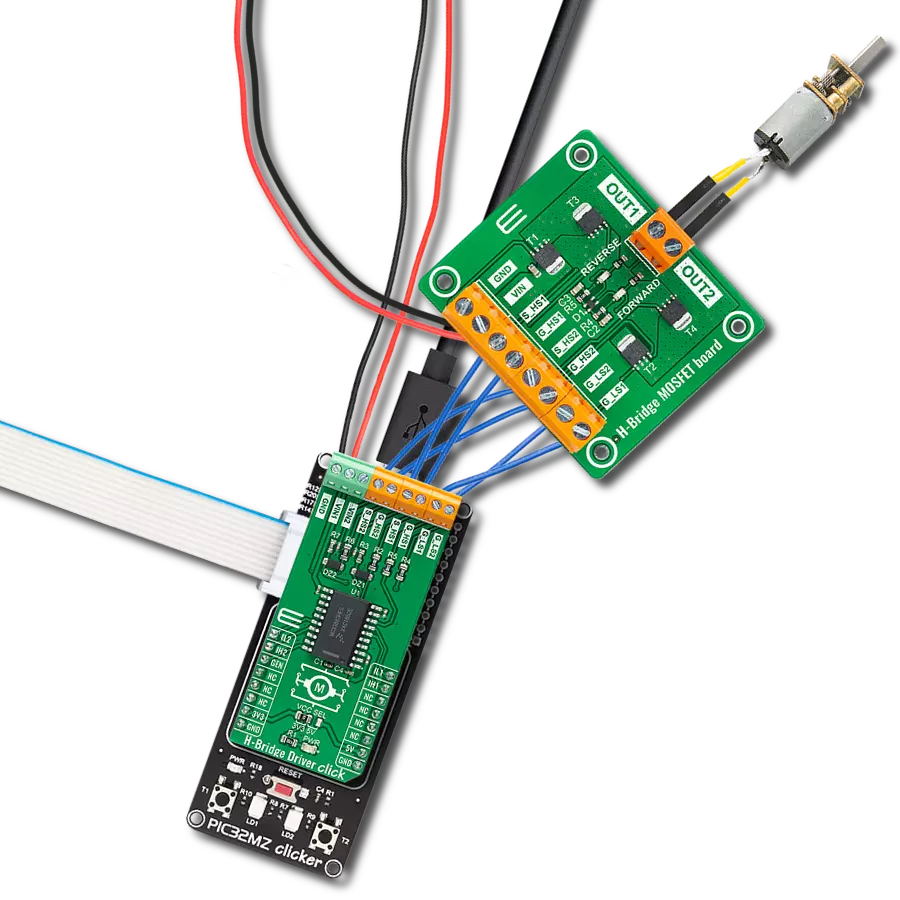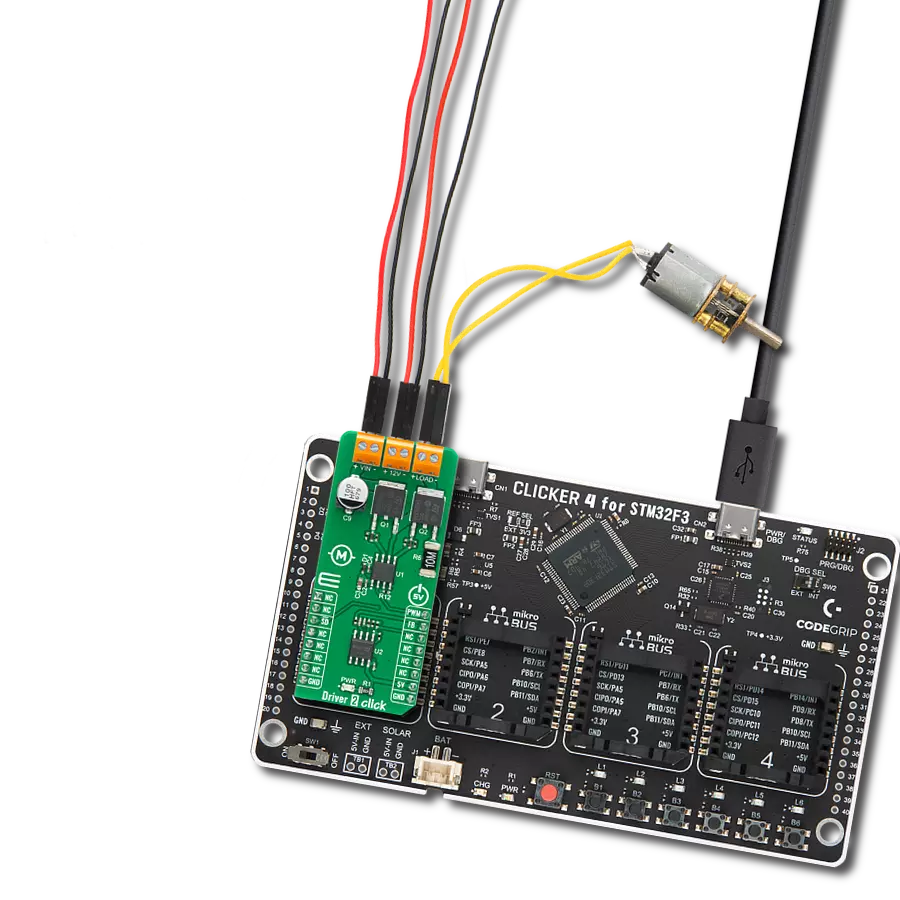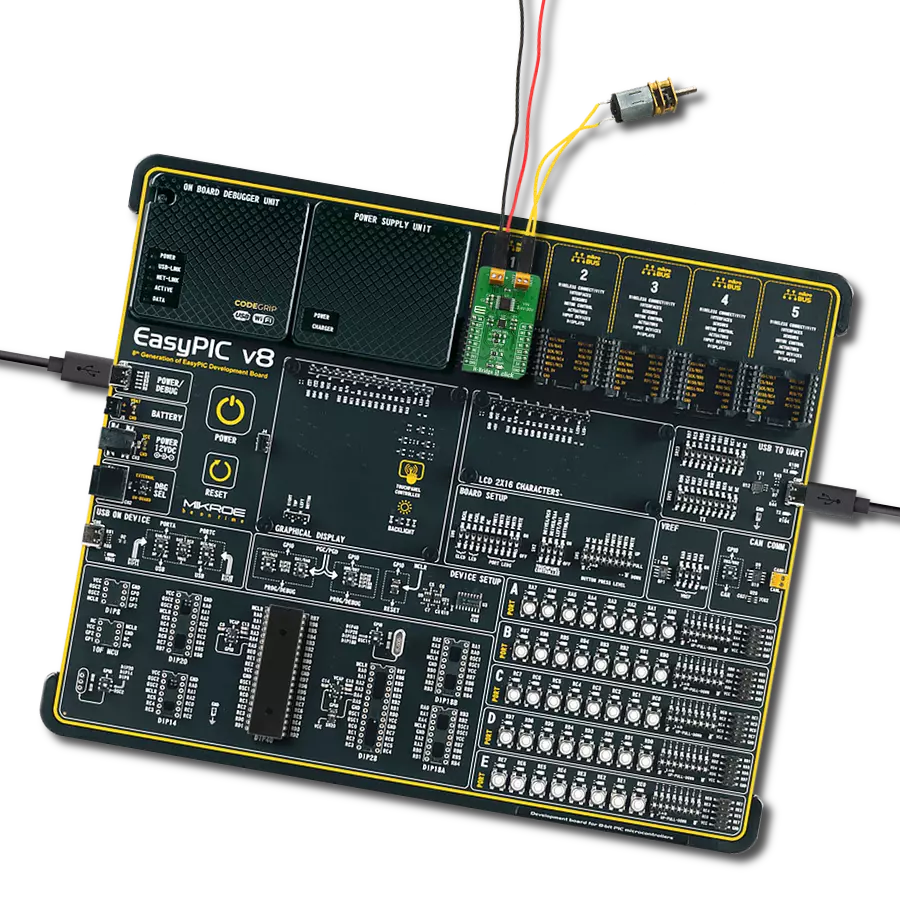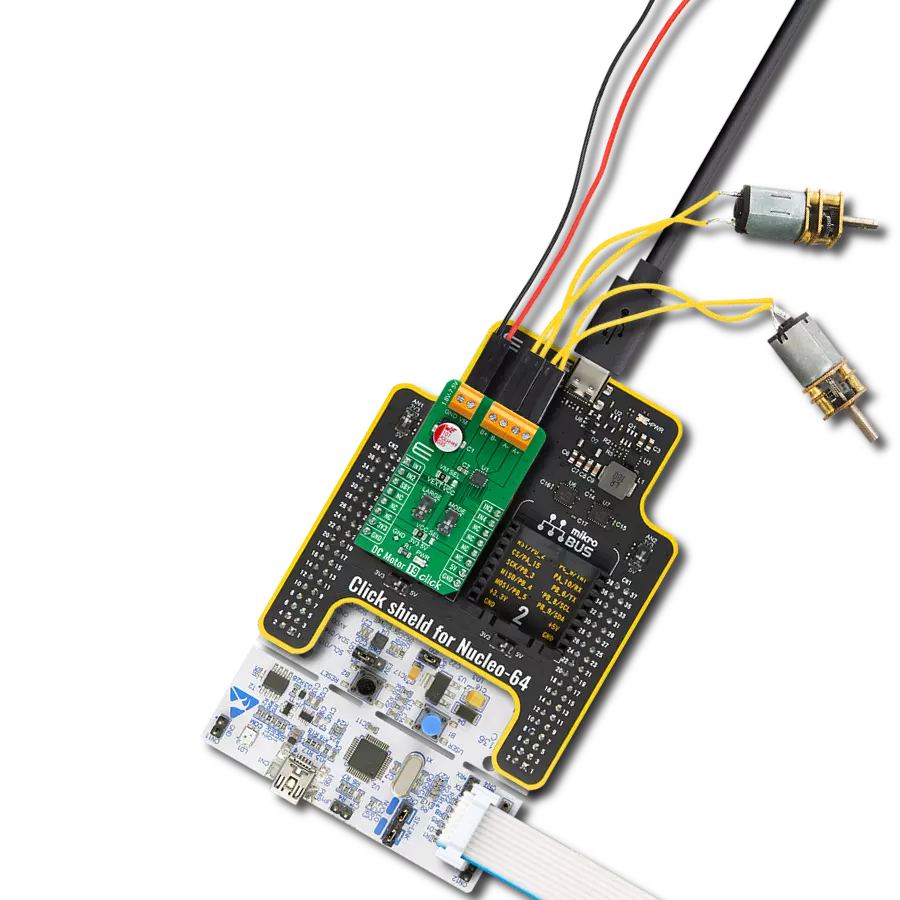Seamlessly combine brushed motor control to deliver unparalleled performance and effortlessly drive motors with impressive voltage capabilities of up to 36 Volts
A
A
Hardware Overview
How does it work?
DC Motor 4 Click is based on the MAX14870, a motor driver from Analog Devices capable of driving motors with a supply voltage from 4.5V to 36V. The Click is designed to run on either 3.3V or 5V power supply. DC Motor 4 Click communicates with the target MCU over the following pins on the mikroBUS™ line: PWM, AN, CS, and INT. The J2 jumper onboard the click selects a power supply - either the onboard 5V or the external DC
motor power supply input. DC Motor 4 Click can be used to drive DC motors, controlling the motor's speed and the direction of the rotation, as well to brake and regulate the current. The MAX14870 motor driver offers a small, low-power solution for driving and controlling brushed DC motors and relays with voltages between 4.5V and 36V. Very low driver on-resistance reduces power dissipation. It features a charge-pump-less design
for reduced external components and low supply current. There are two onboard screw terminals - one for connecting the DC motor and the other for connecting an external source if necessary. The DC motor is controlled through the board's PWM, CS, and AN pins.
Features overview
Development board
Fusion for TIVA v8 is a development board specially designed for the needs of rapid development of embedded applications. It supports a wide range of microcontrollers, such as different 32-bit ARM® Cortex®-M based MCUs from Texas Instruments, regardless of their number of pins, and a broad set of unique functions, such as the first-ever embedded debugger/programmer over a WiFi network. The development board is well organized and designed so that the end-user has all the necessary elements, such as switches, buttons, indicators, connectors, and others, in one place. Thanks to innovative manufacturing technology, Fusion for TIVA v8 provides a fluid and immersive working experience, allowing access
anywhere and under any circumstances at any time. Each part of the Fusion for TIVA v8 development board contains the components necessary for the most efficient operation of the same board. An advanced integrated CODEGRIP programmer/debugger module offers many valuable programming/debugging options, including support for JTAG, SWD, and SWO Trace (Single Wire Output)), and seamless integration with the Mikroe software environment. Besides, it also includes a clean and regulated power supply module for the development board. It can use a wide range of external power sources, including a battery, an external 12V power supply, and a power source via the USB Type-C (USB-C) connector.
Communication options such as USB-UART, USB HOST/DEVICE, CAN (on the MCU card, if supported), and Ethernet is also included. In addition, it also has the well-established mikroBUS™ standard, a standardized socket for the MCU card (SiBRAIN standard), and two display options for the TFT board line of products and character-based LCD. Fusion for TIVA v8 is an integral part of the Mikroe ecosystem for rapid development. Natively supported by Mikroe software tools, it covers many aspects of prototyping and development thanks to a considerable number of different Click boards™ (over a thousand boards), the number of which is growing every day.
Microcontroller Overview
MCU Card / MCU
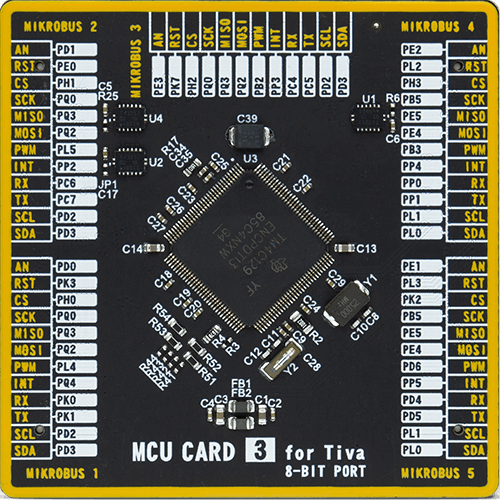
Type
8th Generation
Architecture
ARM Cortex-M4
MCU Memory (KB)
1024
Silicon Vendor
Texas Instruments
Pin count
128
RAM (Bytes)
262144
You complete me!
Accessories
DC Gear Motor - 430RPM (3-6V) represents an all-in-one combination of a motor and gearbox, where the addition of gear leads to a reduction of motor speed while increasing the torque output. This gear motor has a spur gearbox, making it a highly reliable solution for applications with lower torque and speed requirements. The most critical parameters for gear motors are speed, torque, and efficiency, which are, in this case, 520RPM with no load and 430RPM at maximum efficiency, alongside a current of 60mA and a torque of 50g.cm. Rated for a 3-6V operational voltage range and clockwise/counterclockwise rotation direction, this motor represents an excellent solution for many functions initially performed by brushed DC motors in robotics, medical equipment, electric door locks, and much more.
Used MCU Pins
mikroBUS™ mapper
Take a closer look
Click board™ Schematic

Step by step
Project assembly
Software Support
Library Description
This library contains API for DC Motor 4 Click driver.
Key functions:
dcmotor4_set_duty_cycle- Generic sets PWM duty cycledcmotor4_pwm_stop- Stop PWM moduledcmotor4_pwm_start- Start PWM module
Open Source
Code example
The complete application code and a ready-to-use project are available through the NECTO Studio Package Manager for direct installation in the NECTO Studio. The application code can also be found on the MIKROE GitHub account.
/*!
* \file
* \brief DcMotor4 Click example
*
* # Description
* This library contains API for the DC Motor 4 Click driver.
* Application change the speed and direction.
*
* The demo application is composed of two sections :
*
* ## Application Init
* Initialization driver enable's - GPIO,
* set the direction-control of the motor forward movement, PWM initialization,
* set PWM duty cycle and PWM frequency, enable the motor, start PWM.
*
* ## Application Task
* This is an example that demonstrates the use of the DC Motor 4 Click board.
* DC Motor 4 Click communicates with register via PWM interface.
* It shows moving in the Clockwise direction from slow to fast speed
* and from fast to slow speed, then rotating Counter Clockwise,
* Results are being sent to the Usart Terminal where you can track their changes.
*
*
* \author Nikola Peric
*
*/
// ------------------------------------------------------------------- INCLUDES
#include "board.h"
#include "log.h"
#include "dcmotor4.h"
// ------------------------------------------------------------------ VARIABLES
static dcmotor4_t dcmotor4;
static log_t logger;
uint8_t dcmotor_direction = 1;
// ------------------------------------------------------ APPLICATION FUNCTIONS
void application_init ( )
{
log_cfg_t log_cfg;
dcmotor4_cfg_t cfg;
/**
* Logger initialization.
* Default baud rate: 115200
* Default log level: LOG_LEVEL_DEBUG
* @note If USB_UART_RX and USB_UART_TX
* are defined as HAL_PIN_NC, you will
* need to define them manually for log to work.
* See @b LOG_MAP_USB_UART macro definition for detailed explanation.
*/
LOG_MAP_USB_UART( log_cfg );
log_init( &logger, &log_cfg );
log_info( &logger, "---- Application Init ----" );
Delay_ms ( 100 );
// Click initialization.
dcmotor4_cfg_setup( &cfg );
DCMOTOR4_MAP_MIKROBUS( cfg, MIKROBUS_1 );
Delay_ms ( 100 );
dcmotor4_init( &dcmotor4, &cfg );
dcmotor4_pwm_start( &dcmotor4 );
}
void application_task ( )
{
static int8_t duty_cnt = 1;
static int8_t duty_inc = 1;
float duty = duty_cnt / 10.0;
if ( dcmotor_direction == 1 )
{
dcmotor4_run_clockwise ( &dcmotor4 );
log_printf( &logger, "> CLOCKWISE <\r\n" );
}
else
{
dcmotor4_run_counter_clockwise ( &dcmotor4 );
log_printf( &logger, "> COUNTER CLOCKWISE <\r\n" );
}
dcmotor4_set_duty_cycle ( &dcmotor4, duty );
dcmotor4_enable_motor ( &dcmotor4 );
log_printf( &logger, "> Duty: %d%%\r\n", ( uint16_t )( duty_cnt * 10 ) );
Delay_ms ( 500 );
if ( 10 == duty_cnt )
{
duty_inc = -1;
}
else if ( 0 == duty_cnt )
{
duty_inc = 1;
if ( dcmotor_direction == 1 )
{
dcmotor_direction = 0;
}
else
{
dcmotor_direction = 1;
}
}
duty_cnt += duty_inc;
dcmotor4_disable_motor ( &dcmotor4 );
}
int main ( void )
{
/* Do not remove this line or clock might not be set correctly. */
#ifdef PREINIT_SUPPORTED
preinit();
#endif
application_init( );
for ( ; ; )
{
application_task( );
}
return 0;
}
// ------------------------------------------------------------------------ END
Additional Support
Resources
Category:Brushed



















